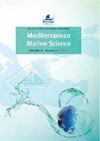Spatial and temporal partitioning of the Western Mediterranean Sea by resident dolphin species
IF 2.3
3区 环境科学与生态学
Q1 MARINE & FRESHWATER BIOLOGY
引用次数: 1
Abstract
A classic issue in ecology is to understand how similar species coexist in a given area (i.e., sympatry). The situation of dolphins in the Western Mediterranean Sea may represent a special case of sympatry in that three similar species (the short-beaked common dolphin [Delphinus delphis], the striped dolphin [Stenella coeruleoalba], and the bottlenose dolphin [Tursiops truncatus) are under strong human impacts in the same area. From the viewpoint of ecology and conservation biology, it is challenging to determine how these three dolphin species live together and avoid competitive exclusion in the setting of such impacts. The Spanish Institute of Oceanography has a dataset of dolphin species opportunistic sightings. Using these data, we constructed three binary variables, comprising the sighting of one species versus the sighting of either of the other two species. We obtained three significant probability models after performing logistic regression of these binary variables on a set of spatio-temporal explanatory variables. We analysed these models from the perspective of fuzzy set theory by applying the favourability function to the probability models, fuzzy operations overlap, and entropy. The results show that common dolphins are differentially favoured in the eastern part of the study area and far away from main shipping routes. The striped dolphin was differentially favoured in the western part of the study area, above deep waters, near main shipping routes, and in summer and spring. Finally, bottlenose dolphins were differentially favoured in the mid-western part of the study area, in winter, and over shallow waters.地中海西部的居住海豚物种的时空划分
生态学中的一个经典问题是理解相似物种如何在特定区域共存(即同域)。西地中海海豚的情况可能代表了一种特殊的同域情况,因为三种类似的物种(短喙普通海豚[Delphinus delphis]、条纹海豚[Stenella coeruleoalba]和宽吻海豚[Tursiops truncatus])在同一地区受到强烈的人类影响。从生态学和保护生物学的角度来看,确定这三种海豚如何共同生活并避免在这种影响的情况下被竞争排斥是一项挑战。西班牙海洋研究所有一个海豚物种偶然目击的数据集。利用这些数据,我们构建了三个二元变量,包括一个物种的目击与其他两个物种中任何一个的目击。在对一组时空解释变量进行这些二元变量的逻辑回归后,我们获得了三个显著概率模型。我们从模糊集理论的角度分析了这些模型,将偏好函数应用于概率模型、模糊运算重叠和熵。结果表明,普通海豚在研究区域的东部和远离主要航线的地方受到不同的青睐。条纹海豚在研究区域的西部、深水上方、主要航线附近以及夏季和春季受到不同的青睐。最后,宽吻海豚在研究区域的中西部、冬季和浅水区受到不同的青睐。
本文章由计算机程序翻译,如有差异,请以英文原文为准。
求助全文
约1分钟内获得全文
求助全文
来源期刊

Mediterranean Marine Science
MARINE & FRESHWATER BIOLOGY-
CiteScore
5.20
自引率
17.90%
发文量
34
审稿时长
>12 weeks
期刊介绍:
The journal Mediterranean Marine Science (MMS), published by the Hellenic Centre for Marine Research (HCMR), issues three volumes annually. The journal welcomes original research articles, short communications, New Mediterranean Biodiversity records, extended reviews, comments, and Theme sections in all fields of Oceanography, Marine Biology, Marine Conservation, Fisheries and Aquaculture in the Mediterranean area and the adjacent regions. All content is peer reviewed.
 求助内容:
求助内容: 应助结果提醒方式:
应助结果提醒方式:


